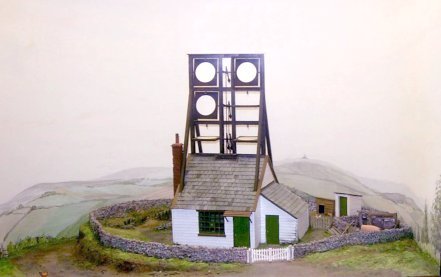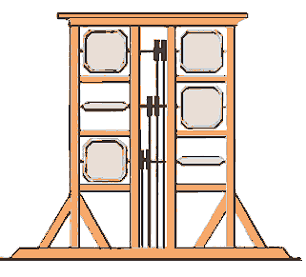Long before the electric telegraph could be made to work reliably - because no suitable insulator could be found - the French government built a network of semaphore signalling stations ...
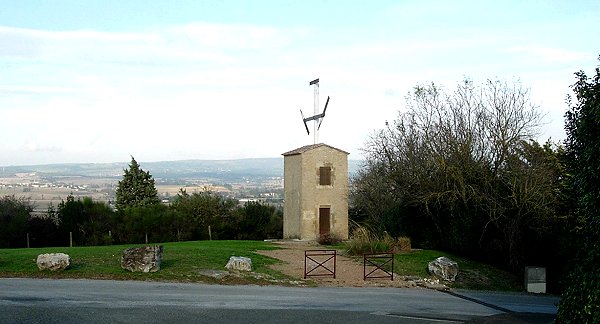
Castelnaudary is a small town near Toulouse, in the south-west of France, famed as the place where cassoulet was invented.
(Actually, several French towns claim this honour, but it says Castelnaudary on most of the tins of cassoulet sold in French supermarkets, so that's good enough for me.)
Ten minutes walk from the town centre took us to this strange stone tower. It looks like a very small barn with oddly shaped antennas on the roof.
In fact, it was originally built in about 1800 as part of a network of signalling stations that linked Paris to other major French cities - by semaphore!
How did the network come to be built?
Semaphore
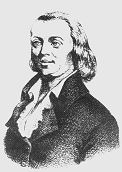
Claude Chappe
Claude Chappe was born in 1763. He was sent to a seminary, whilst his brothers attended a nearby private school, and (the story goes) he pondered how they might send messages to each other. Synchronised clocks might possibly work. But he must also have considered semaphore, which has been used in one form or another for signalling since ancient times.
Navies used it routinely, and in fact, Robert Hooke had experimented with a system based on mechanical arms a hundred years earlier, but it had failed to stir the interest of the British Army.

There were of course no Boy Scouts in those days, but I like to imagine Chappe experimenting with a couple of flags ...
... because the eventual idea, after many setbacks and failures, boiled down to semaphore. He decided to construct a sort of enormous mechanical Boy Scout, complete with mechanical flags. Standing on top of a tall building or a hilltop, the giant's waving arms would be visible for miles.
The first experiments
Chappe's education at the seminary led to a comfortable job as the head of a small religious community near Brûlon. The clock experiments continued, and soon he felt able to stir some public interest in the system. In 1791 he and his brother demonstrated a working system that operated over a distance of 4 leagues (about 15km) between the towns of Brûlon and Parcé. Local dignitaries were invited to watch. Here is an eye-witness account of the event:

Pendule means clock.
Procès-verbal de la première expérience publique faite dans le département de la Sarthe, par MM. Chappe.
Aujourd'hui 2 mars 1791, sur les onze heures du matin, nous soussignés officiers municipaux de Parcé, district de Sablé, département de la Sarthe, accompagnés de MM Francois Delauney de Fresney, Julien Delauney de La Motte, Léon Delauney, Prosper Delauney, René Taillay, Jean-André Tellot, notaire royal et électeur du département de la Mayenne, tous demeurant à Laval; Etienne Eutrope Brossard, notaire royal à Avoise; Jean-Baptiste-Joseph Gillier de la Cheverollais, curé de Saint-Pierre de Parcé.
Sur l'invitation qui nous a été faite par M. Claude Chappe, nous nous sommes transportés a la Maison de M. Ambroise Perrotin, située audit bourg de Parcé, a l'effet de constater le résultat d'une découverte ayant pour objet de se communiquer et de correspondre dans l'espace de temps le plus rapproché.
D'abord nous sommes montés avec ledit sieur Claude Chappe dans une des chambres de ladite maison, où nous avons trouvé un pendule et un télescope dirigé du côté de Brulon, distant à Parcé de quatre lieues. De suite ledit sieur Claude Chappe fixant Brulon avec son télescope, nous a annoncé que, bien encore que le temps fut pluvieux, son correspondant à Brulon alloit néanmoins commencer a procéder a la transmission de ce qui alloit lui etre dicté par MM. les officiers municipaux dudit lieu; et continuant d'avoir l'oeil attaché au télescope, il a successivement, et dans l'espace de quatre minutes, dicté au sieur Pierre Francois Chappe, son frère, plusieurs caractères, à nous inconnus. Version faites desdits caractères, il en est résulté la phrase suivante: Si vous réussissez vous serez bientôt couvert de gloire.
Faite et arrêté a Parcé, en la maison dudit sieur Perrotin, avant l'heure de midi, dits jour et an.
Suivent les signatures:
LEBLAYE, officier municipal; POTTIER, procureur de la commune; FRANCOIS DELAUNEY DE FRESNEY; J. DELAUNEY DE LA MOTTE; DELAUNEY, consul a Oran; PROSPER DELAUNEY; FOUREILLE, officier municipal; TAILLAY; TELLOT; BROSSARD; GILLIER, curé; FRANCOIS CHAPPE; CLAUDE CHAPPE, abbé.
Source: Histoire de la Télégraphie, par M. Chappe l'Ainé, Paris, 1824, pp.234-6
In essence, the statement says that Chappe's assistant in Brûlon transmitted a message dictated to him by that town's officials, whilst Chappe and his brother, watching from the house in Parcé, decoded the message. It read: "If you succeed, you will soon be covered with glory!" Transmission and decoding took four minutes. The covering-with-glory stage took rather longer.
Another message was successfully transmitted that afternoon, and yet another the following day. The system seemed to work. And to remove any suspicion of collusion or fraud, the officials at Brûlon also signed statements confirming the messages they had sent.
Chappe and his brother had succeeded in transmitting a mechanically encoded message between two towns by using a pair of synchronised clocks. They must have felt proud of themselves, energised and ready to extend their system across the country. They cannot possibly have imagined the size of the mountain they had set out to climb.
The national system
The authorities in Paris took notice, and the brothers were invited to repeat their demonstration in the capital. They built a machine (presumably, a larger version of their special clock) on the city wall close to where the Arc de Triomphe now stands. The suspicious citizens stared at it, didn't understand it, didn't like it, and smashed it to bits during the night.
Six months later the brothers tried again. They had abandoned the clock idea. This time they built a structure containing five moveable shutters. The citizens promptly burned it down, and nearly threw the brothers onto the fire too.
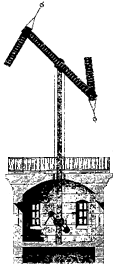
A section through a Chappe tower.
They did not give up, though the shutter idea too was scrapped. By now they had concluded that a system of moving arms - the giant Boy Scout - was probably the way to go. This idea was presented to the Legislative Assembly in March 1792, which referred it to a committee, which reported a year later that it might possibly work. The brothers were given official permission to erect three prototype stations.
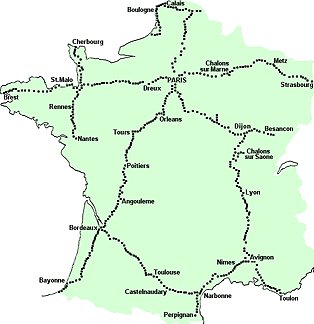
Developing a prototype into a successful system is not usually straightforward, and it always takes longer than anyone expects. Nevertheless, by the end of the following year (1794) Paris was linked to Lille by a chain of signalling stations.
The mechanical aspects of the design had been made satisfactory, the route had been surveyed, local authorities persuaded of the importance of the venture, sites found for the towers, money and permissions obtained, builders hired, operatives hired and trained, code books written and agreed, control signals sorted out, and civil servants found to administer and pay for the complex network.
It continued to grow rapidly. The line was soon extended to Dunkirk, and even to Amsterdam and Brussels. In 1798 lines were built to Brest, and to Strasbourg. In the space of a very few years, all the major French cities were linked to Paris, and the network eventually reached as far as Milan. With transmission speeds of two or three symbols per minute, it took no more than a couple of hours for a message to reach the furthest corners of the network.
The system continued to operate for another fifty years, until it was eventually susperseded by the electric telegraph. (The French authorities were intially mistrustful of a cable-based system. Suppose someone were to cut the wire?)
But Chappe himself, far from being covered in glory, had constantly to fight claims that the true credit belonged to the clockmaker Breguet who had designed and perfected the mechanism by which the arms were controlled. Then, tragically, Claude Chappe developed cancer, and in 1805 he killed himself.
How did it work?
The semaphore arms
Victor Hugo called it "a great black insect" - but then, he had never seen a Boy Scout.
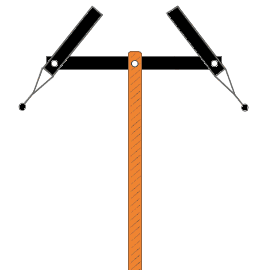
On top of the tower were three linked arms, each capable of being moved independently by an operator at ground level by a system of ropes and pulleys.
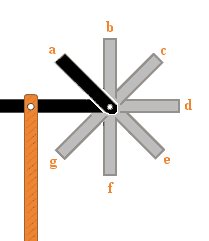
The central arm (4.6m long, with 3 pivots) was called the regulator. The other arms (1.3m long, and counterbalanced by weights) were known as the indicators.
Each of the indicator arms could be rotated into one of seven recognisably different positions. In addition, the regulator could be positioned to be either horizontal or vertical.
So there were altogether 7 x 7 x 2 = 98 different possible combinations of position, and each of these represented one symbol. With only 26 letters in the alphabet, this is obviously far more than would be needed to spell out a message one letter at a time. A symbol could represent a word, or a syllable, or even a complete phrase.
A later refinement was to transmit some symbols in pairs. With 92 distinct symbols, the arrangement was to have a code book of 92 pages, each with 92 lines, allowing 92 x 92 = 8,464 words and phrases.

Transmitting each signal could involve the operator hauling on three separate ropes to achieve the required combination of arm positions.
Encoding
Messages had to be encoded before they could be transmitted, which had the added benefit of making them unreadable by the station operators, or indeed by anyone else who chose to interest themselves in what the whirling arms might be saying. Presumably the more complex code book was introduced to decrease transmission time at the expense of increased decoding time (though with greatly increased security.) Only senior officials at the large cities had access to the code books.
Control signals
Besides the symbols themselves, any signalling system needs to include a means for sending special signals such as "are you ready for the next symbol?" and "ignore the last symbol" and "end of message" and "please wait - I have a problem" as well as a method of handshaking (like "I think you sent ..." and "that was not what I sent".) These signals are vital. The system couldn't work without them, and I had intended to explore how the Chappe brothers solved this problem, and then compare it with more modern solutions.
Several websites claim to describe the special signals, but I have little confidence in any of them since they contradict one another. Some say that six of the 98 symbols were reserved for system use, leaving 92 (and later, 92 x 92) for the code book. Some claim that the regulator was set at 45 degrees one way for some of the system signals, and 45 degrees the other way for handshaking. Some say that one of the indicator arms was folded inward (leaving it obscured by the regulator) for system signals. It's all very confusing, and I can't untangle it.
However, here is a list of the control signals that I think were used. It is said to be taken from La Télégraphie Chappe, Editions de l'Est, FNARH. These signals - and only these, I assume - could be transmitted by an individual operator as the need arose. All other signal would be re-transmitted down the line, exactly as they were received.
- High priority - a signal from Paris
- Lower priority - a signal from a Provincial director
- Message received and understood
- End of transmissions for the day
- You did not copy my last signal correctly
- I cannot see (because of fog, or snow)
- Temporary breakdown, which I will repair
- Serious breakdown, which I cannot repair
- An intermediate station is blocking or slowing transmission
- Please continue transmission
- My last signal was incorrect
- Please repeat your last signal
- Please wait - I cannot accept further signals for 15 minutes, or 30 minutes, or one hour, or two hours
- I need to interrupt your transmission with a priority message from the other direction
- Synchronise your clock with mine when my indicator swings to the vertical
Bit rate
The original message (suggesting Chappe would be "covered in glory") contained 55 characters. Assuming 8 bits per character, and ignoring headers, footers and other extraneous characters, that's 440 bits. Transmission and decoding took 240 seconds, giving 1.8 bits/sec.
The semaphore system took (say) 20 seconds to transmit a symbol of (say) 5 letters. That's roughly 40 bits. So the speed between stations was probably around 2 bits/second. It's not broadband, but between Paris and Milan it's a lot faster than a horse.
The Castelnaudary system
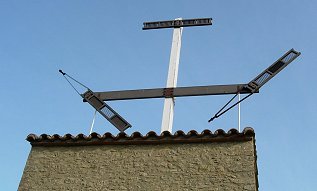
Confusingly, the signalling arms on the tower at Castelnaudary don't look like the arms in any of the contemporary sketches. A helpful booklet supplied by the local tourist office explains that, here, the short horizontal bar at the top is the regulator, and the large horizontal bar carrying the indicators didn't move.
This design was apparently known as the "systéme Flocon", and was introduced during the middle of the 19th century in an attempt to mitigate the effects of the wind. The more common design was known as "systéme Milan". I haven't found other sources that confirm this.
The English system
During the Napoleonic war ...
The English authorities knew what the French had achieved. The Channel Fleet blockading Brest must have been well aware of the significance of the signalling tower they could see on the hilltop. Forester writes in Hornblower and the Hotspur
Automatically, Hornblower looked over again at the Petit Minou. As he expected, the semaphore arms of the telegraph on the cliffs at the point there were swinging jerkily, from vertical to horizontal and back again. The watchers there were signalling to the French fleet the news of the arrival of this fourth ship to join the inshore squadron; even the smallest activity was noted and reported, so that in clear weather the French admiral was informed within minutes. It was an intolerable nuisance ...
... and eventually, Hornblower leads a landing party to deal with the "nuisance". (Yes, I know Hornblower was a fictional character, but Forester's research was impeccable. I do enjoy the Hornblower novels.)
Lord George Murray, the Bishop of St. David's, devised a semaphore system based on shutters, and persuaded the Admiralty to adopt it in 1795. Links were built to some important coastal towns, and according to Wikipedia a message could be passed from London to Deal in about a minute. The system was scrapped at the end of the Napoleonic wars.
The clacks
The shutter telegraph is of course well known on the Discworld. Pratchett writes in The fifth elephant:
Lord Vetinari stood at his window watching the semaphore tower on the other side of the river. All eight of the big shutters facing him were blinking furiously - black, white, white, black, white ...
Information was flying into the air. Twenty miles behind him, on another tower in Sto Lat, someone was looking through a telescope and shouting out numbers.
How quickly the future comes upon us, he thought.
And yet I doubt that the shutters were really "blinking furiously". The operators first had to pull on ropes to position all the shutters correctly. Then their position had to be checked. Then the station down the line at Sto Lat had to repeat the signal, and the Ankh-Morpork station had to check that the signal had been received correctly. Only then could the next signal be sent. If they could manage to do all that in 15 seconds, they would be working hard. It took the Chappe operators 20 or 30 seconds. But then, perhaps the shutters in Pratchett's story were powered by small demons (before the lucky discovery of all those golems)...
Sources
Contemporary sources are scarce, apart from Histoire de la telegraphie which was published in 1824 and written by someone who knew his subject. It's accessible though Google books and elsewhere.
There are several websites that mention the Chappe telegraph. Many of them contradict each other, and some are plainly wrong, but one or two include 19th century engravings and nice photographs of rebuilt towers.
Here are a couple of sites that I found helpful.
One appears to be a school research project . It's written in frames, and bits of it don't work properly. But it does include a nice animation (click on "Les Depeches" and scroll down) that illustrates how the author thinks a signal was transmitted from one station to the next, including handshaking. It might even be correct.
A more formal and comprehensive overview appears here, including the image of a bar of chocolate depicting Chappe as one of the Benefactors of Humanity. And of course there's always Wikipedia.
The image of the shutter telegraph station is © Royal Signals Museum, Blandford.

